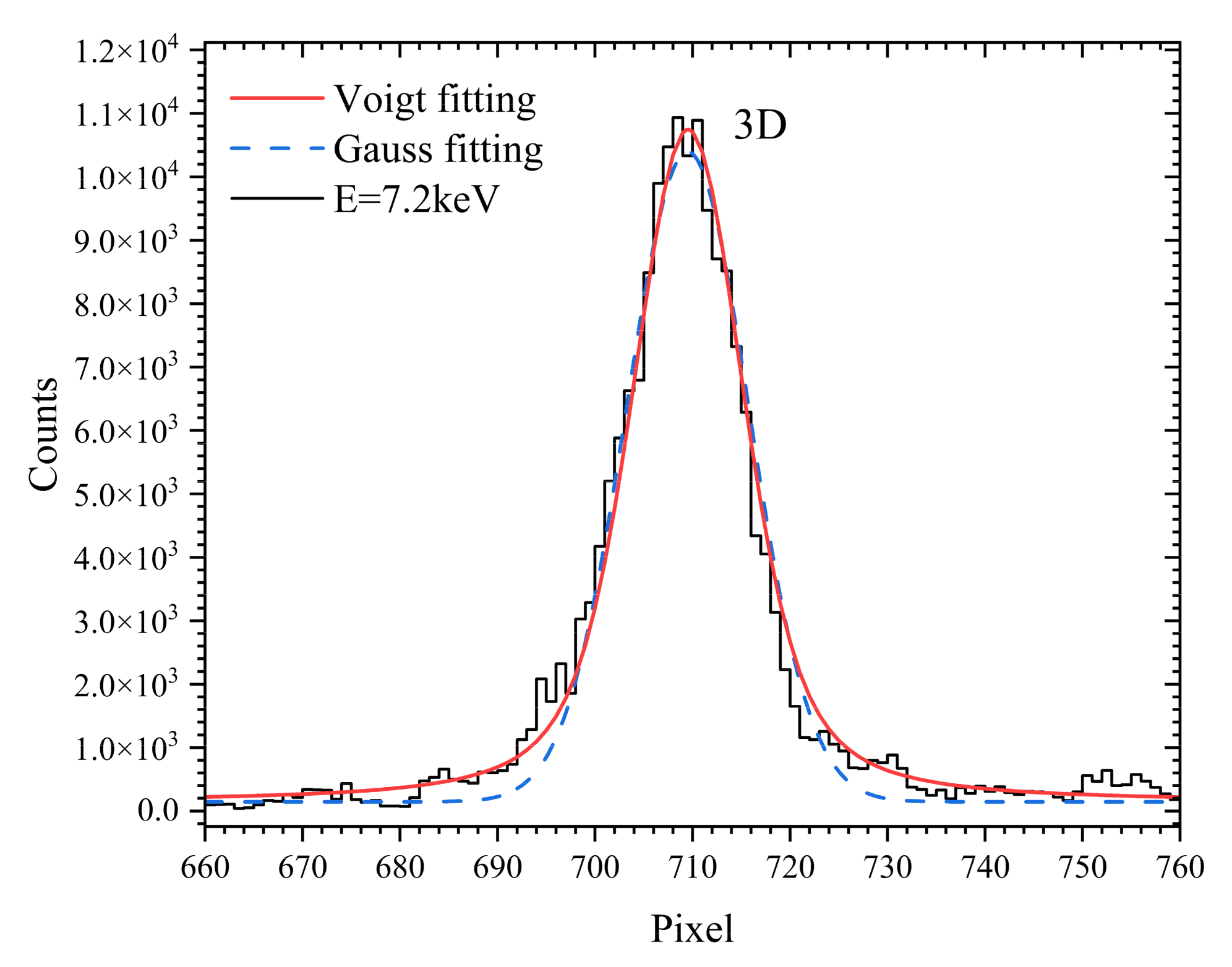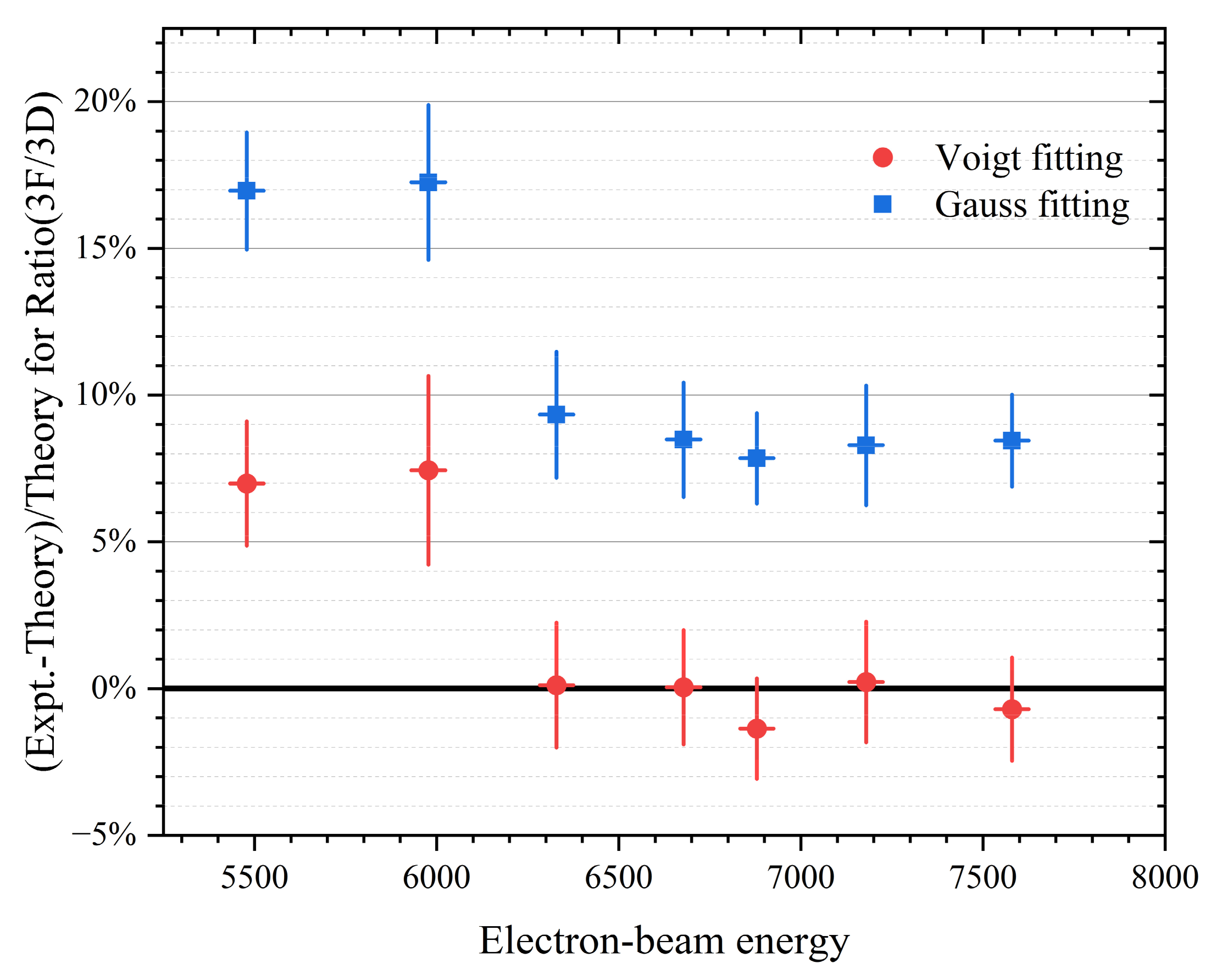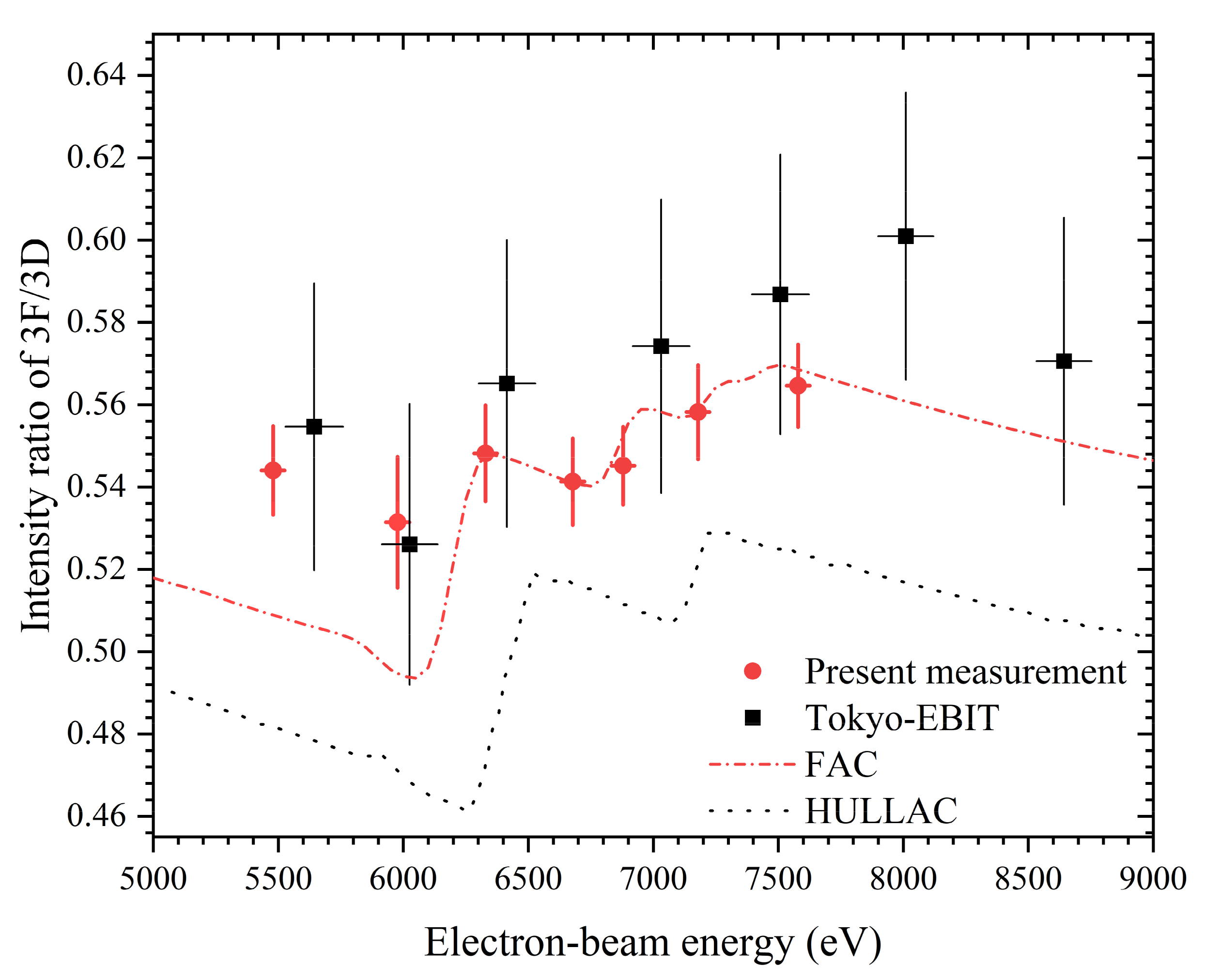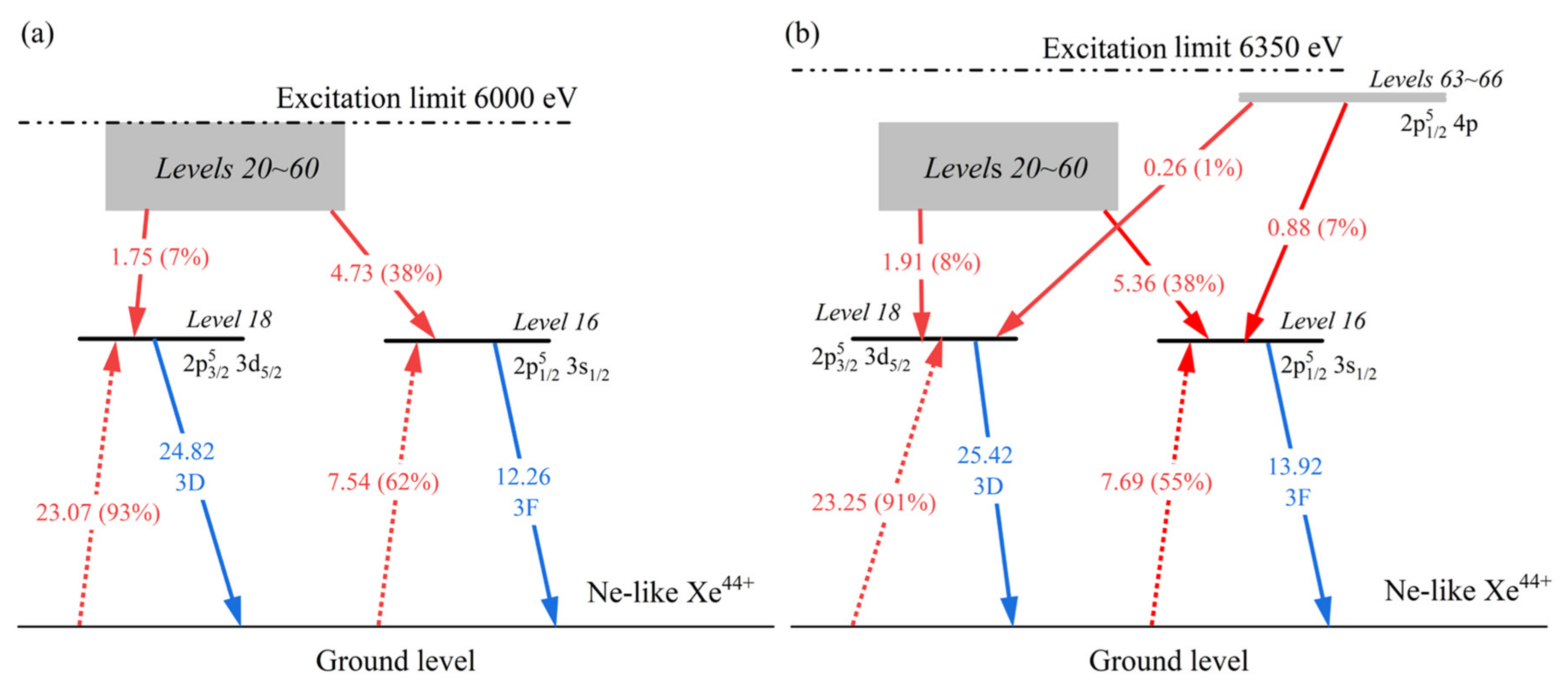X-ray Line-Intensity Ratios in Neon-like Xenon: Significantly Reducing the Discrepancy between Measurements and Simulations
Abstract
1. Introduction
2. Experimental Setup
3. Calculations
4. Results and Discussion
5. Summary
Author Contributions
Funding
Data Availability Statement
Conflicts of Interest
References
- Hill, K.W.; Bitter, M.; Delgado-Aparicio, L.; Johnson, D.; Feder, R.; Beiersdorfer, P.; Dunn, J.; Morris, K.; Wang, E.; Reinke, M.; et al. Development of a spatially resolving x-ray crystal spectrometer for measurement of ion-temperature (Ti) and rotation-velocity (v) profiles in ITER. Rev. Sci. Instrum. 2010, 81, 10E322. [Google Scholar] [CrossRef] [PubMed]
- Beiersdorfer, P.; Clementson, J.; Dunn, J.; Gu, M.F.; Morris, K.; Podpaly, Y.; Wang, E.; Bitter, M.; Feder, R.; Hill, K.W.; et al. The ITER core imaging x-ray spectrometer. J. Phys. B At. Mol. Opt. Phys. 2010, 43, 144008. [Google Scholar] [CrossRef]
- Cheng, Z.; Bader, A.; De Bock, M.; Barnsley, R.; Lorriere, P.; Pablant, N.; Costa, F.; Soeiro, J.; Bola, I.; O’Mullane, M.; et al. Novel dual-reflection design applied for ITER core x-ray spectrometer. Rev. Sci. Instrum. 2022, 93, 073502. [Google Scholar] [CrossRef] [PubMed]
- Lu, D.; Chen, J.; Wang, F.; Delgado-Aparicio, L.F.; Fu, J.; Zhang, H.; Bin, B.; He, L.; Shen, J.; Wang, Q.; et al. Design consideration of an x-ray imaging crystal spectrometer for China Fusion Engineering Test Reactor. Rev. Sci. Instrum. 2021, 92, 043544. [Google Scholar] [CrossRef] [PubMed]
- Delgado-Aparicio, L.F. Xe option for Ti and vt measurements in ITER. In Proceedings of the 32nd Meeting of ITPA Topical Group on Diagnostics, Chengdu, China, 9–12 May 2017. [Google Scholar]
- Beiersdorfer, P.; von Goeler, S.; Bitter, M.; Hinnov, E.; Bell, R.; Bernabei, S.; Felt, J.; Hill, K.W.; Hulse, R.; Stevens, J.; et al. X-ray transitions in highly charged neonlike ions. Phys. Rev. A 1988, 37, 4153–4162. [Google Scholar] [CrossRef]
- Hu, R.J.; Chen, J.; Delgado-Aparicio, L.F.; Wang, Q.P.; Du, X.W.; Shen, J.; Yang, X.S.; Wang, F.D.; Fu, J.; Li, Y.Y.; et al. Upgrade of X-ray crystal spectrometer for high temperature measurement using neon-like xenon lines on EAST. Rev. Sci. Instrum. 2018, 89, 10F110. [Google Scholar] [CrossRef]
- Rice, J.E.; Fournier, K.B.; Kemp, G.E.; Bitter, M.; Cao, N.; Delgado-Aparicio, L.; Hill, K.; Hubbard, A.E.; Hughes, J.W.; Reinke, M.L. X-ray observations of Ne-like Xe and satellites from C-Mod tokamak plasmas. J. Phys. B At. Mol. Opt. Phys. 2020, 53, 055701. [Google Scholar] [CrossRef]
- Lu, D.; Wang, F.; Delgado-Aparicio, L.F.; Yang, Y.; Hill, K.; Bae, C.; Bitter, M.; Fu, J.; Zhang, H.; Shen, Y.; et al. Observations of xenon spectra on the EAST x-ray crystal spectrometer for high-temperature plasma diagnostics. Nucl. Fusion 2023, 63, 056002. [Google Scholar] [CrossRef]
- Liu, H.; Wang, F.; Fu, J.; Jin, Y.; He, L.; Lu, D.; Bae, C.; Zhang, H.; Fu, S.; Ji, H.; et al. Upgrade of poloidal and tangential x-ray imaging crystal spectrometers on EAST tokamak. In Proceedings of the 5th Optics Young Scientist Summit (OYSS 2022), Fuzhou, China, 16–19 September 2022; Lu, C.-Y., Chen, F., Li, Z., Cai, Y., Eds.; SPIE: Fuzhou, China, 2022; p. 96. [Google Scholar]
- Werner, T.; Zschornack, G.; Großmann, F.; Ovsyannikov, V.P.; Ullmann, E. X-ray Spectroscopy of Neon-like Xenon at the Dresden EBIT. Phys. Scr. 2001, T92, 241–243. [Google Scholar] [CrossRef]
- Nakamura, N.; Kato, D.; Ohtani, S. Evidence for strong configuration mixing in n=3 excited levels in neonlike ions. Phys. Rev. A 2000, 61, 052510. [Google Scholar] [CrossRef]
- Kentsch, U.; Zschornack, G.; Grossmann, F.; Ovsyannikov, V.P.; Ullmann, F.; Fritzsche, S. L x-ray transitions in F-like to Na-like xenon ions determined at a room temperature electron beam ion trap. X-Ray Spectrom. 2006, 35, 71–78. [Google Scholar] [CrossRef]
- Yang, Z.; He, Z.; Xiong, G.; Yao, K.; Yang, Y.; Wei, B.; Zou, Y.; Wu, Z.; Tian, Z.; Ma, Y.; et al. Apparent change of the 3C/3D line intensity ratio in neonlike ions. Opt. Express 2022, 30, 25326. [Google Scholar] [CrossRef] [PubMed]
- Kato, D.; Nakamura, N.; Ohtani, S.; Ohtani, S.; Sasaki, A. Z-Dependence of Photo-Emission Spectra for Highly Charged Neonlike Ions. Phys. Scr. 2001, T92, 126–129. [Google Scholar] [CrossRef]
- Kato, D.; Nakamura, N.; Shunsuke, O. X-Ray Spectral Analysis on Electron Interaction with Highly-Charged Ions in Tokyo-EBIT. J. Plasma Fusion Res. 2006, 7, 190–194. [Google Scholar]
- Beiersdorfer, P. Spectroscopy with trapped highly charged ions. Phys. Scr. 2009, T134, 014010. [Google Scholar] [CrossRef]
- Keane, C.J.; Lee, R.W.; Hammel, B.A.; Osterheld, A.L.; Suter, L.J.; Calisti, A.; Khelfaoui, F.; Stamm, R.; Talin, B. Line broadening of Ne-like xenon as a diagnostic for high-density implosion experiments. Rev. Sci. Instrum. 1990, 61, 2780–2782. [Google Scholar] [CrossRef]
- Conturie, Y.; Yaakobi, B.; Feldman, U.; Doschek, G.A.; Cowan, R.D. Observation of new lines of Xe xliv, xlv, xlvi, and xlvii in the range 2.5–3.0 Å from laser-imploded targets. J. Opt. Soc. Am. 1981, 71, 1309–1314. [Google Scholar] [CrossRef]
- Keane, C.J.; Hammel, B.A.; Kania, D.R.; Kilkenny, J.D.; Lee, R.W.; Osterheld, A.L.; Suter, L.J.; Mancini, R.C.; Hooper, C.F.; Delamater, N.D. X-ray spectroscopy of high-energy density inertial confinement fusion plasmas. Phys. Fluids B Plasma Phys. 1993, 5, 3328–3336. [Google Scholar] [CrossRef]
- Aglitskii, E.V.; Ivanova, E.P.; Panin, S.A.; Safronova, U.I.; Ulityn, S.I.; Vainshtein, L.A.; Wyart, J.-F. Investigation of the spectra of dipole 2–3 transitions in Ne-like ions ( Z = 36–92). Phys. Scr. 1989, 40, 601–609. [Google Scholar] [CrossRef]
- Hu, L.Q.; Liu, Y. Progress of engineering design of CFETR diagnostics. Fusion Eng. Des. 2020, 155, 111731. [Google Scholar] [CrossRef]
- Hutton, R.; Zou, Y.; Andersson, M.; Brage, T.; Martinson, I. Some historic and current aspects of plasma diagnostics using atomic spectroscopy. J. Phys. B At. Mol. Opt. Phys. 2010, 43, 144026. [Google Scholar] [CrossRef]
- Beiersdorfer, P. Highly charged ions in magnetic fusion plasmas: Research opportunities and diagnostic necessities. J. Phys. B At. Mol. Opt. Phys. 2015, 48, 144017. [Google Scholar] [CrossRef]
- Rice, J.E.; Fournier, K.B.; Goetz, J.A.; Marmar, E.S.; Terry, J.L. X-ray observations of 2l-nl’ transitions and configuration-interaction effects from Kr, Mo, Nb and Zr in near neon-like charge states from tokamak plasmas. J. Phys. B At. Mol. Opt. Phys. 2000, 33, 5435–5462. [Google Scholar] [CrossRef]
- Beiersdorfer, P.; Lepson, J.K.; Schneider, M.B.; Bode, M.P. L -shell x-ray emission from neonlike W64+. Phys. Rev. A 2012, 86, 012509. [Google Scholar] [CrossRef]
- Li, J.; Grumer, J.; Li, W.; Andersson, M.; Brage, T.; Hutton, R.; Jönsson, P.; Yang, Y.; Zou, Y. Theoretical investigation of magnetic-field-induced 2p53s 3P0,2–2p6 1S0transitions in Ne-like ions without nuclear spin. Phys. Rev. A 2013, 88, 013416. [Google Scholar] [CrossRef]
- Syrocki, Ł.; Słabkowska, K.; Węder, E.; Polasik, M.; Rzadkiewicz, J. Theoretical Modeling of High-Resolution X-ray Spectra Emitted by Tungsten and Molybdenum Ions from Tokamak Plasmas. J. Fusion Energy 2020, 39, 194–201. [Google Scholar] [CrossRef]
- Young, B.K.F.; Osterheld, A.L.; Walling, R.S.; Goldstein, W.H.; Phillips, T.W.; Stewart, R.E.; Charatis, G.; Busch, G.E. Measurement of density-sensitive electric quadrupole transitions in neonlike laser-produced plasmas. Phys. Rev. Lett. 1989, 62, 1266–1269. [Google Scholar] [CrossRef] [PubMed]
- Keane, C.J.; Hammel, B.A.; Osterheld, A.L.; Kania, D.R. Density and temperature sensitive features in high temperature plasma L-shell xenon emission spectra. Phys. Rev. Lett. 1994, 72, 3029–3032. [Google Scholar] [CrossRef]
- Shevelko, A.P.; Yakushev, O.F.; Vainshtein, L.A.; Andreev, S.N.; Tolstikhina, I.Y. X-ray spectroscopy comparison methods for diagnostics of high-temperature molybdenum plasmas. Phys. Plasmas 2018, 25, 073306. [Google Scholar] [CrossRef]
- Träbert, E.; Beiersdorfer, P.; López-Urrutia, J.R.C. Atomic lifetime measurements of Ne-like Fe ions in a magnetic field. Nucl. Instrum. Methods Phys. Res. Sect. B Beam Interact. Mater. Atoms 2017, 408, 107–109. [Google Scholar] [CrossRef]
- Beiersdorfer, P.; López-Urrutia, J.R.C.; Träbert, E. Measurement of the radiative decay rate and energy of the metastable level in Fe xvii. Astrophys. J. 2016, 817, 67. [Google Scholar] [CrossRef]
- Paerels, F.B.S.; Kahn, S.M. High-Resolution X-Ray Spectroscopy with Chandra and XMM-Newton. Annu. Rev. Astron. Astrophys. 2003, 41, 291–342. [Google Scholar] [CrossRef]
- Behar, E.; Cottam, J.; Kahn, S.M. The Chandra Iron-L X-Ray Line Spectrum of Capella. Astrophys. J. 2001, 548, 966–975. [Google Scholar] [CrossRef]
- Brown, G.V.; Beiersdorfer, P.; Chen, H.; Chen, M.H.; Reed, K.J. Diagnostic utility of the relative intensity of 3C to 3D IN Fe xvii. Astrophys. J. 2001, 557, L75. [Google Scholar] [CrossRef]
- Schmelz, J.T.; Saba, J.L.R.; Chauvin, J.C.; Strong, K.T. Investigating the Effect of Opacity in Soft X-Ray Spectral Lines Emitted by Solar Coronal Active Regions. Astrophys. J. 1997, 477, 509–515. [Google Scholar] [CrossRef]
- Beiersdorfer, P.; Von Goeler, S.; Bitter, M.; Thorn, D.B. Measurement of the 3d → 2p resonance to intercombination line-intensity ratio in neonlike Fe XVII, Ge XXIII, and Se XXV. Phys. Rev. A 2001, 64, 032705. [Google Scholar] [CrossRef]
- Brown, G.V.; Beiersdorfer, P.; Chen, H.; Scofield, J.H.; Boyce, K.R.; Kelley, R.L.; Kilbourne, C.A.; Porter, F.S.; Gu, M.F.; Kahn, S.M.; et al. Energy-Dependent Excitation Cross Section Measurements of the Diagnostic Lines of Fe XVII. Phys. Rev. Lett. 2006, 96, 253201. [Google Scholar] [CrossRef] [PubMed]
- Nikulin, V.K.; Trzhaskovskaya, M.B. Comment on “Energy-Dependent Excitation Cross Section Measurements of the Diagnostic Lines of Fe XVII. ” Phys. Rev. Lett. 2012, 108, 139301. [Google Scholar] [CrossRef] [PubMed]
- Bernitt, S.; Brown, G.V.; Rudolph, J.K.; Steinbrügge, R.; Graf, A.; Leutenegger, M.; Epp, S.W.; Eberle, S.; Kubiček, K.; Mäckel, V.; et al. An unexpectedly low oscillator strength as the origin of the Fe xvii emission problem. Nature 2012, 492, 225–228. [Google Scholar] [CrossRef]
- Kühn, S.; Shah, C.; López-Urrutia, J.R.C.; Fujii, K.; Steinbrügge, R.; Stierhof, J.; Togawa, M.; Harman, Z.; Oreshkina, N.S.; Cheung, C.; et al. High Resolution Photoexcitation Measurements Exacerbate the Long-Standing Fe XVII Oscillator Strength Problem. Phys. Rev. Lett. 2020, 124, 225001. [Google Scholar] [CrossRef]
- Mendoza, C.; Bautista, M.A. Theoretical Confirmation of the Low Experimental 3C/3D f -Value Ratio in Fe xvii. Phys. Rev. Lett. 2017, 118, 163002. [Google Scholar] [CrossRef] [PubMed]
- Oreshkina, N.S.; Cavaletto, S.M.; Keitel, C.H.; Harman, Z. Astrophysical Line Diagnosis Requires Nonlinear Dynamical Atomic Modeling. Phys. Rev. Lett. 2014, 113, 143001. [Google Scholar] [CrossRef] [PubMed]
- Brown, G.V. A brief review of the intensity of lines 3C and 3D in neon-like Fe XVII. Can. J. Phys. 2008, 86, 199–208. [Google Scholar] [CrossRef]
- Kühn, S.; Cheung, C.; Oreshkina, N.S.; Steinbrügge, R.; Togawa, M.; Bernitt, S.; Berger, L.; Buck, J.; Hoesch, M.; Seltmann, J.; et al. New Measurement Resolves Key Astrophysical Fe XVII Oscillator Strength Problem. Phys. Rev. Lett. 2022, 129, 245001. [Google Scholar] [CrossRef] [PubMed]
- Santana, J.A.; Lepson, J.K.; Träbert, E.; Beiersdorfer, P. Electron-correlation effects on the 3C to 3D line-intensity ratio in the Ne-like ions Ar8+ to Kr26+. Phys. Rev. A 2015, 91, 012502. [Google Scholar] [CrossRef]
- Fournier, K.B.; Hansen, S.B. Resolution of the long-standing overprediction of the resonance to intercombination line-intensity ratio in mid-Z neonlike ions. Phys. Rev. A 2005, 71, 012717. [Google Scholar] [CrossRef]
- Chen, G.-X. Converged Dirac R-matrix calculation of electron impact excitation of Fe XVII. Phys. Rev. A 2007, 76, 062708. [Google Scholar] [CrossRef]
- Gu, M.F.; Beiersdorfer, P.; Brown, G.V.; Chen, H.; Boyce, K.R.; Kelley, R.L.; Kilbourne, C.A.; Porter, F.S.; Kahn, S.M. Laboratory Measurements of 3 → 2 X-Ray Emission Lines of Ne-like Ni xix. Astrophys. J. 2004, 607, L143–L146. [Google Scholar] [CrossRef]
- Panchenko, D.; Beiersdorfer, P.; Hell, N.; Brown, G.V.; Kelley, R.; Kilbourne, C.A.; Porter, F.S. Resonance-to-intercombination-line ratios of neonlike ions in the relativistic regime. Phys. Rev. A 2017, 95, 062503. [Google Scholar] [CrossRef]
- Wu, C.; Gao, X. Change of the relative line strengths due to the resonance induced population transfer between Fe XVII and FeXVI ions. Sci. Rep. 2019, 9, 7463. [Google Scholar] [CrossRef]
- Chen, G.X. X-ray line ratio 3C/3D in Fe xvii. Mon. Not. R. Astron. Soc. Lett. 2008, 386, L62–L66. [Google Scholar] [CrossRef]
- Loch, S.D.; Ballance, C.P.; Li, Y.; Fogle, M.; Fontes, C.J. Non-equilibrium modeling of the fe xvii 3C/3D line ratio in an intense x-ray free-electron laser excited plasma. Astrophys. J. 2015, 801, L13. [Google Scholar] [CrossRef]
- Wu, Z.W.; Tian, Z.Q.; An, Y.H.; Dong, C.Z. Angular Distribution and Polarization of the 3C and 3D Lines Following Electron-impact Excitation of Fe16+ Ions. Astrophys. J. 2021, 910, 142. [Google Scholar] [CrossRef]
- Petkov, E.E.; Safronova, A.S.; Kantsyrev, V.L.; Stafford, A.; Safronova, U.I.; Shlyaptseva, V.V.; Beiersdorfer, P.; Hell, N.; Brown, G.V. Polarization measurements of Ne-like Mo32+ x-ray lines excited by an electron beam. J. Phys. B At. Mol. Opt. Phys. 2019, 52, 195002. [Google Scholar] [CrossRef]
- Beiersdorfer, P.; Scofield, J.H.; Brown, G.V.; Chen, M.H.; Hell, N.; Osterheld, A.L.; Vogel, D.A.; Wong, K.L. Avoided level crossings in very highly charged ions. Phys. Rev. A 2016, 93, 051403. [Google Scholar] [CrossRef]
- Beiersdorfer, P.; Obst, M.; Safronova, U.I. Radiative decay probabilities of the ( 2s22p51/23s1/2) J=0 level in neonlike ions. Phys. Rev. A 2011, 83, 012514. [Google Scholar] [CrossRef]
- Safronova, U.I.; Cowan, T.E.; Safronova, M.S. Relativistic many-body calculations of electric-dipole lifetimes, transition rates and oscillator strengths for 2l−1 3l′ states in Ne-like ions. J. Phys. B At. Mol. Opt. Phys. 2005, 38, 2741–2763. [Google Scholar] [CrossRef]
- Yang, Z.; Chen, G.; Zhong, Y.; Zhang, C.; Tu, H.; Luo, T.; He, Z.; Hu, Z. Effect of the configuration mixing on the polarization and angular distribution of x-ray line emissions following electron-impact excitation of Ne-like ions. Opt. Express 2024, 32, 9877. [Google Scholar] [CrossRef] [PubMed]
- Lu, D.; Yang, Y.; Xiao, J.; Shen, Y.; Fu, Y.; Wei, B.; Yao, K.; Hutton, R.; Zou, Y. Upgrade of the electron beam ion trap in Shanghai. Rev. Sci. Instrum. 2014, 85, 093301. [Google Scholar] [CrossRef]
- Zhu, X.; Liu, Y.; Wang, X.; Liu, Y.; Guo, P.; Lu, D.; Zhang, X.; Hu, W.; He, M.; Liljeby, L.; et al. Status of the Shanghai EBIT. Nucl. Instrum. Methods Phys. Res. Sect. B Beam Interact. Mater. At. 2005, 235, 509–513. [Google Scholar] [CrossRef]
- Theodosiou, C.E.; Curtis, L.J. Accurate calculations of 3p and 3d lifetimes in the Na sequence. Phys. Rev. A 1988, 38, 4435–4445. [Google Scholar] [CrossRef] [PubMed]
- Rodrigues, G.C.; Indelicato, P.; Santos, J.P.; Patté, P.; Parente, F. Systematic calculation of total atomic energies of ground state configurations. At. Data Nucl. Data Tables 2004, 86, 117–233. [Google Scholar] [CrossRef]
- Vilkas, M.J.; López-Encarnación, J.M.; Ishikawa, Y. Relativistic multireference Møller–Plesset perturbation theory calculations of the energy levels and transition probabilities in Ne-like xenon, tungsten, and uranium ions. At. Data Nucl. Data Tables 2008, 94, 50–70. [Google Scholar] [CrossRef]
- Lu, Q.; He, J.; Tian, H.; Li, M.; Yang, Y.; Yao, K.; Chen, C.; Xiao, J.; Li, J.G.; Tu, B.; et al. Observation of indirect ionization of W7+ in an electron-beam ion-trap plasma. Phys. Rev. A 2019, 99, 042510. [Google Scholar] [CrossRef]
- Liang, G.Y.; Crespo López-Urrutia, J.R.; Baumann, T.M.; Epp, S.W.; Gonchar, A.; Lapierre, A.; Mokler, P.H.; Simon, M.C.; Tawara, H.; Mäckel, V.; et al. Experimental investigations of ion charge distributions, effective electron densities, and electron-ion cloud overlap in electron beam ion trap plasma using extreme-ultraviolet spectroscopy. Astrophys. J. 2009, 702, 838–850. [Google Scholar] [CrossRef]
- Tu, B.; Lu, Q.F.; Cheng, T.; Li, M.C.; Yang, Y.; Yao, K.; Shen, Y.; Lu, D.; Xiao, J.; Hutton, R.; et al. Characteristics of the Shanghai high-temperature superconducting electron-beam ion trap and studies of the space-charge effect under ultralow-energy operating conditions. Phys. Plasmas 2017, 24, 103507. [Google Scholar] [CrossRef]
- Yang, Y.; Lu, D.; Fu, Y.-Q.; Yao, K.; Chen, W.-D.; Xiao, J.; Geng, Z.-X.; Zou, Y.-M. Electron beam density study using a portable slit imaging system at the Shanghai Electron Beam Ion Trap. Chin. Phys. B 2011, 20, 080701. [Google Scholar] [CrossRef]
- Yang, Y.; Xiao, J.; Lu, D.; Shen, Y.; Yao, K.; Chen, C.; Hutton, R.; Zou, Y. A high precision flat crystal spectrometer compatible for ultra-high vacuum light source. Rev. Sci. Instrum. 2017, 88, 113108. [Google Scholar] [CrossRef] [PubMed]
- Xiao, J.; Gao, Y.; Zhang, X.; Lu, D.; Hu, W.; Gao, M.; Chen, W.; Zou, Y. High resolution flat crystal spectrometer for the Shanghai EBIT. Rev. Sci. Instrum. 2008, 79, 093101. [Google Scholar] [CrossRef]
- Rzadkiewicz, J.; Yang, Y.; Kozioł, K.; O’Mullane, M.G.; Patel, A.; Xiao, J.; Yao, K.; Shen, Y.; Lu, D.; Hutton, R.; et al. High-resolution tungsten spectroscopy relevant to the diagnostic of high-temperature tokamak plasmas. Phys. Rev. A 2018, 97, 052501. [Google Scholar] [CrossRef]
- Li, Y.; Wang, Y.; Fan, J.; Si, R.; Li, J.; Zhang, M.; Huang, L.; Xiao, J.; Zou, Y.; Wei, B.; et al. Precise wavelength determination of the 4s24p 2P3/2–2P1/2 transition in Mo11+ and Ru13+ ions. J. Phys. B At. Mol. Opt. Phys. 2021, 54, 235001. [Google Scholar] [CrossRef]
- Gu, M.F. The Flexible Atomic Code. In Proceedings of the AIP Conference Proceedings; AIP: Santa Fe, NM, USA, 2004; Volume 730, pp. 127–136. [Google Scholar]
- Gu, M.F. Electron-impact excitation of Fe XXII: Comparative study of relativistic R -matrix and distorted-wave approaches. Phys. Rev. A 2004, 70, 062704. [Google Scholar] [CrossRef]
- Gu, M.F. The flexible atomic code. Can. J. Phys. 2008, 86, 675–689. [Google Scholar] [CrossRef]
- Ding, X.; Zhang, F.; Yang, Y.; Zhang, L.; Koike, F.; Murakami, I.; Kato, D.; Sakaue, H.A.; Nakamura, N.; Dong, C. Collisional-radiative modeling of the 5 p−5 s spectrum of W xiv–W xvi ions. Phys. Rev. A 2020, 101, 042509. [Google Scholar] [CrossRef]
- Ding, X.; Yang, J.; Zhu, L.; Koike, F.; Murakami, I.; Kato, D.; Sakaue, H.A.; Nakamura, N.; Dong, C. Collisional radiative model for the M1 transition spectrum of the highly-charged W 54+ ions. Phys. Lett. A 2018, 382, 2321–2325. [Google Scholar] [CrossRef]
- Słabkowska, K.; Polasik, M.; Syrocki, Ł.; Szymańska, E.; Rzadkiewicz, J.; Pereira, N.R. Modeling of the M X-ray line structures for tungsten and L X-ray line structures for molybdenum. J. Phys. Conf. Ser. 2015, 583, 012036. [Google Scholar] [CrossRef]
- Kozioł, K.; Brosławski, A.; Patel, A.; Weisen, H.; Rzadkiewicz, J. Ion temperature spectroscopic measurements in high rotation discharges by means of X-ray diagnostic at JET. J. Instrum. 2022, 17, C07008. [Google Scholar] [CrossRef]
- Xie Hui-Qiao; Tan Yi; Liu Yang-Qing; Wang Wen-Hao; Gao Zhe; Department of Engineering Physics, Tsinghua University, Beijing 100084, China A collisional-radiative model for the helium plasma in the sino-united spherical tokamak and its application to the line intensity ratio diagnostic. Acta Phys. Sin. 2014, 63, 125203. [CrossRef]
- Liang, G.Y.; Zhao, G.; Zeng, J.L.; Shi, J.R. Identification and analysis of soft X-ray lines of Ar xiii-Ar xvi in laboratory and astrophysical plasmas. Mon. Not. R. Astron. Soc. 2004, 350, 298–306. [Google Scholar] [CrossRef]
- Biedermann, C.; Radtke, R.; Fournier, K.B. Spectroscopy of heliumlike argon resonance and satellite lines for plasma temperature diagnostics. Phys. Rev. E 2002, 66, 066404. [Google Scholar] [CrossRef]
- Widmann, K.; Beiersdorfer, P.; Decaux, V.; Elliott, S.R.; Knapp, D.; Osterheld, A.; Bitter, M.; Smith, A. Studies of He-like krypton for use in determining electron and ion temperatures in very-high-temperature plasmas. Rev. Sci. Instrum. 1995, 66, 761–763. [Google Scholar] [CrossRef]
- Lewis, G.N.; Mayer, J.E. The quantum laws and the uncertainty principle of heisenberg. Proc. Natl. Acad. Sci. USA 1929, 15, 127–139. [Google Scholar] [CrossRef] [PubMed]
- Beiersdorfer, P.; Osterheld, A.L.; Decaux, V.; Widmann, K. Observation of Lifetime-Limited X-Ray Linewidths in Cold Highly Charged Ions. Phys. Rev. Lett. 1996, 77, 5353–5356. [Google Scholar] [CrossRef] [PubMed]
- Kunze, H.-J. Introduction to Plasma Spectroscopy; Springer Series on Atomic, Optical, and Plasma Physics; Springer: Berlin/Heidelberg, Germany, 2009; Volume 56, ISBN 978-3-642-02232-6. [Google Scholar]
- Doron, R.; Behar, E. The X-Ray Spectrum of Fe 16+ Revisited with a Multi-Ion Model. Astrophys. J. 2002, 574, 518–526. [Google Scholar] [CrossRef]
- Gu, M.F. Indirect X-Ray Line-Formation Processes in Iron L-Shell Ions. Astrophys. J. 2003, 582, 1241–1250. [Google Scholar] [CrossRef]





| Ee (keV) | Ie (mA) | Time (h) |
|---|---|---|
| 5.50 | 42.3 | 34 |
| 6.00 | 47.8 | 18 |
| 6.35 | 45.0 | 22 |
| 6.70 | 48.5 | 28 |
| 6.90 | 47.0 | 20 |
| 7.20 | 48.3 | 14 |
| 7.60 | 48.0 | 22 |
| Experiment | Theory | |||||||
|---|---|---|---|---|---|---|---|---|
| Charge | Label | Upper Level | Lower Level | λmeasured | λother | λFAC | Δ | Intensity |
| 44 | 3D | (2p53/23d5/2)J=1 | (2p6)J=0 | 2.7203 (1) | 2.7203 (1) a,b | 2.72057 | 0.010% | 23.98 |
| 43 | Na1 | (2p53/23p22)J=1/2 | (2p63s)J=1/2 | 2.7240 (2) | 2.7240 d | 2.72385 | −0.006% | 2.96 |
| 44 | 3F | (2p51/2 3s1/2)J=1 | (2p6)J=0 | 2.7288 (1) | 2.7288 (1) a,b | 2.72945 | 0.023% | 12.20 |
| 43 | 3DNa | (2p53/23s1/23d5/2)J=3/2 | (2p63s)J=1/2 | 2.7358 (2) | 2.7358 (2) a,c | 2.73595 | 0.006% | 18.41 |
| 43 | Na2 | (2p53/23p1/23d5/2)J=1/2 | (2p63p1/2)J=1/2 | 2.7408 (2) | 2.74103 | 0.009% | 1.99 | |
| 42 | 3DMg | (2p53/23s23d5/2)J=1 | (2p63s2)J=0 | 2.7460 (2) | 2.7460 (2) a,c | 2.74505 | −0.035% | 11.94 |
| 44 | 3E | (2p53/23d3/2)J=1 | (2p6)J=0 | 2.7534 (2) | 2.7535 (2) c | 2.75425 | 0.030% | 1.33 |
| 42 | Mg1 | (2p53/23s1/23p22)J=1 | (2p63s2)J=0 | 2.7595 (2) | 2.7596 (2) c | 2.75975 | 0.010% | 3.62 |
Disclaimer/Publisher’s Note: The statements, opinions and data contained in all publications are solely those of the individual author(s) and contributor(s) and not of MDPI and/or the editor(s). MDPI and/or the editor(s) disclaim responsibility for any injury to people or property resulting from any ideas, methods, instructions or products referred to in the content. |
© 2024 by the authors. Licensee MDPI, Basel, Switzerland. This article is an open access article distributed under the terms and conditions of the Creative Commons Attribution (CC BY) license (https://creativecommons.org/licenses/by/4.0/).
Share and Cite
Huang, S.; Tang, Z.; Yang, Y.; Zhang, H.; Tian, Z.; Ma, S.; Li, J.; Zeng, C.; Ji, H.; Yao, K.; et al. X-ray Line-Intensity Ratios in Neon-like Xenon: Significantly Reducing the Discrepancy between Measurements and Simulations. Appl. Sci. 2024, 14, 4381. https://doi.org/10.3390/app14114381
Huang S, Tang Z, Yang Y, Zhang H, Tian Z, Ma S, Li J, Zeng C, Ji H, Yao K, et al. X-ray Line-Intensity Ratios in Neon-like Xenon: Significantly Reducing the Discrepancy between Measurements and Simulations. Applied Sciences. 2024; 14(11):4381. https://doi.org/10.3390/app14114381
Chicago/Turabian StyleHuang, Shihan, Zhiming Tang, Yang Yang, Hongming Zhang, Ziqiang Tian, Shaokun Ma, Jinyu Li, Chao Zeng, Huajian Ji, Ke Yao, and et al. 2024. "X-ray Line-Intensity Ratios in Neon-like Xenon: Significantly Reducing the Discrepancy between Measurements and Simulations" Applied Sciences 14, no. 11: 4381. https://doi.org/10.3390/app14114381
APA StyleHuang, S., Tang, Z., Yang, Y., Zhang, H., Tian, Z., Ma, S., Li, J., Zeng, C., Ji, H., Yao, K., & Zou, Y. (2024). X-ray Line-Intensity Ratios in Neon-like Xenon: Significantly Reducing the Discrepancy between Measurements and Simulations. Applied Sciences, 14(11), 4381. https://doi.org/10.3390/app14114381






